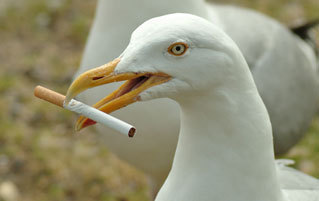5 Shockingly Creative Ways Animals Are Using Our Garbage

Humanity is pretty good at subjugating nature. In just a few short millennia, we inbred one of the most powerful apex predators evolution could muster, the gray wolf, into the Chihuahua, a hairless rat that couldn't win a fight with a strong breeze. And that's just what we did on purpose. Our little "accidents" have been such a fierce torrent of environmental nut shots that you'd expect nature to be nothing but a quivering mass of weeping extinction by now. But somehow, the natural world keeps finding a way ...
Birds Use Cigarette Butts to Fight Off Parasites

Cigarettes are bad news, and not just for us: Animals that live near humans are stuck with billions of pounds of non-biodegradable butts to deal with. Now, normally we'd make a joke here about your mom's ass, but this is just too sad:

Except that it's not, really.
It turns out that not all animals mind: Some birds are purposefully seeking out cigarette butts to line their nests because the nicotine that cigarette butts absorb while you're smoking them is pretty effective at combating the kinds of mites that plague bird nests. Researchers discovered this after planting heat traps lined with both smoked and unsmoked cigarettes butts in the nests of common house finches and sparrows. After a mere 20 minutes, the scientists found that traps with unsmoked butts had caught roughly twice as many mites as the traps with smoked butts. So, if anything, rather than disposing of your cigarettes properly, just toss that bird a fresh smoke every once in a while.

Of course, being a general bummer, the scientists also pointed out that, while protective and beneficial in this one very specific instance, nicotine is still generally poisonous as all hell, so ashing your American Spirits into a baby bird's mouth doesn't count as your good deed for the day. What you can take away from these findings, however, is that even parasitic bird mites are turned off by smokers.
Nuclear Fallout Helps Thwart Poachers

Rivaled only by fast food and masturbation, nuclear weapons are the premier symbol of man's ability to screw itself on a species-wide scale. Not everyone realizes quite how broad the repercussions are: The bombings of Hiroshima and Nagasaki and the more than 2,000 nuclear weapon tests conducted thereafter (not to mention the nonviolent nuclear catastrophes at Chernobyl and Fukushima) have contaminated soil, water, air, and even the very cells of living organisms with measurable levels of carbon-14. If radiation worked the way it does in comic books, we'd all be comic book characters by now. But it turns out that having cancer isn't a superpower, so we guess all these decoder rings were for nothing.

Oddly enough, the deadly footprint left by nuclear fallout has become an unexpected ally in the fight against the illegal ivory trade, which kills tens of thousands of elephants every year. By measuring the amount of carbon-14 in a given piece of ivory against the "bomb curve" (the shorthand for leftover carbon-14 floating around our atmosphere), scientists can figure out when an animal died. They then can use that information to figure out if it was killed illegally and in some cases track down the poachers responsible. In short, scientists are deducing crimes via radiation like a post-nuclear Sherlock Holmes. It's not a permanent solution (the technique will only last for another 15 years or so, when background levels will stop being measurable), but in the meantime, helping to save endangered species from human-driven extinction is at least a bit of a silver lining in that ominous, mushroom-shaped cloud.

Turtles Love Some Golf Courses

Pretty much the entire sport of golf is one deep-swinging ecological crotch punch, with everything from the building of the course to the balls themselves having massively harmful side effects. And yet golf courses can also be an environmental wonderland for a number of different animals. Some research suggests that properly managed golf courses are incredibly beneficial for a plethora of birds, beetles, and especially turtles. So what accounts for the difference?

It's all in how you build it. On some courses, only a small fraction of the landscape is used for the actual swinging of sticks while wearing stupid pants; the rest is just scenic surroundings that you only experience firsthand if you hook a shot into the rough. So barring the rare crash from an exceptionally shitty golfer, it's a sweet hangout pad for nature in the middle of the city. Some of the more flattened courses -- the ones that usually replace delicate and rare marshlands -- end up having a more negative impact, but in the end, it seems like an even split. About half of all golf courses are hate crimes against Mother Earth, but the other half actually manage to cultivate a greater ecological value than farmlands or nature reserves.

So loving nature and enjoying a shockingly expensive walk with occasional club-swinging breaks aren't always mutually exclusive pastimes. If we just put a little effort into not actively ruining the habitat, we can still enjoy "hockey for people who hate teamwork and excitement" to our heart's content.

Moose Use Roads as Day Cares

It seems like human progress has been especially bad for the humble moose: Evolution made them too big, slow, and comically dimwitted to handle the raging murderection of humanity. Why, look at the dangers posed by speeding cars alone: There were only 25,000 moose in Idaho when the state did a survey in 2007. Compare that to 1939, when there were far fewer roads and ... only 1,000 moose? Wait, what the hell?

While most animals are moderately to severely screwed when humans move into a new spot, moose actually like what we've done with the place. When we cut down trees, we open up wide areas that those big clumsy behemoths can more comfortably populate, and we promote the growth of shrubs, which are easier for those lovable lumbering bastards to eat. Even more surprising, when the Wildlife Conservation Society stuck radio transmitters on Wyoming moose to check where they go and why, they found that pregnant moose were giving birth closer and closer to the roads that run through Grand Teton National Park.

Why? Because areas near roads tend to be safer. While the risk of being hit by a truck is substantially higher near a road than, say, beneath a pleasant waterfall in the remote wilderness, drivers aren't actually trying to hit a moose, for the same reason they're not trying to hit solid brick walls that can kick you to death.

But other things in the park are very much stalking moose -- like the grizzly bear, a vicious carnivore that loves baby moose meat almost as much as it fears roads. The lack of grizzly bears, which are the leading cause of moose calf deaths, makes the open road the best place to raise a baby moose. Of course, there's a downside: Moose have only displayed this behavior in areas with increased bear presence -- they don't just hang out by the highway because they dig the open road, man. And slowly, bears are learning that they have to overcome their fear of roads if they want to eat. That's right: The moose are setting us up for an invasion by the bear army.
Sea Life Love Melting Icecaps

Now, we're not going to argue that global warming is good for us overall. We've seen the documentaries: When the ice caps melt, giant waves will cover the Statue of Liberty, ice storms will freeze cities solid, all of the planet's roads will dramatically crumble beneath the feet of strong-jawed protagonists, and Kevin Costner will swim the Earth as the mer-Messiah.

"I'm already drinking recycled pee in preparation."
And good lord, it's already happening! As we march inexorably toward total environmental catastrophe, more and more icebergs are breaking off from the polar ice shelves and falling into the ocean, where they melt and release tons of iron and other minerals into the sea. Those minerals are presumably, like, forming together into ocean meteorites that will be launched from the seas by the immense pressure of accumulating carbon dioxide to-
No? They're just being gobbled up by microscopic phytoplankton whose increasing numbers in turn stimulate the entire oceanic food chain from the bottom up? Well, what the hell kind of dystopia is that? We doubt even the raw star power of a Costner or a Cusack could sell that movie.

But it's true: A 2007 study in the Weddell Sea found that the growing number of icebergs had increased biological activity by 40 percent. That's good for the fishies, but bad for the two-leggers, right? Not exactly: Aside from feeding animals, the microorganisms that feed off the icebergs are one of the biggest suckers of carbon dioxide from the atmosphere. Granted, this is a case of fixing with your right hand what you break with the left (climate change is still hitting us pretty hard, and the immense suckage of phytoplankton alone won't stop it), but it's a real testament to the Earth's forgiving adaptability. That's just how Mother Nature works: She takes the good, she takes the bad, she takes them both, and then you have the environment.
Related Reading: It's important to remember JUST how big a thumb our species can stick in Mother Nature's eye. Case in point: laser lightning. For the exact opposite thing, click here and learn about crabs the size of your car. The war between man and nature is an unstoppable conflict, learn the history of that war here.
